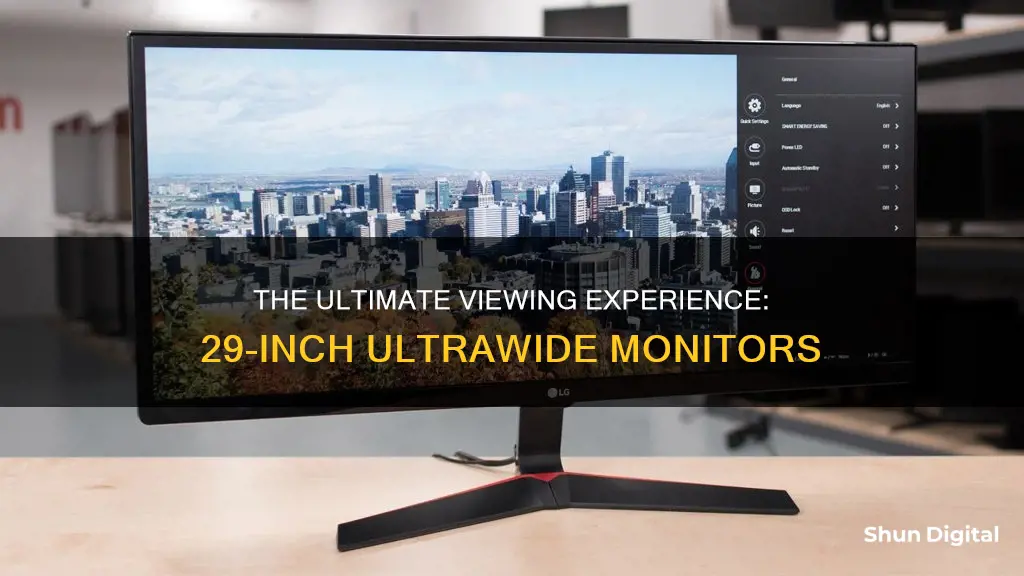
Ultrawide monitors provide more horizontal screen space than traditional 16:9 monitors, making them ideal for those who like to have multiple windows open at the same time. While they are designed with gaming in mind, they also offer good office performance. Most ultrawide monitors have a 34-inch screen size, but there are larger options available, known as super ultrawide monitors, which can be up to 49 inches.
The LG 29UM68-P is a 29-inch ultrawide monitor with a 21:9 aspect ratio. It has a resolution of 2560 x 1080 pixels and a refresh rate of 56-75Hz. Its dimensions are 702.5 x 328.4 x 63.8 mm.
What You'll Learn
- Ultrawide monitors are 21:9 or 32:9 aspect ratio
- They provide more horizontal screen space than 16:9 monitors
- Ultrawide monitors are great for multi-window tasks
- They are often designed with gaming in mind but also offer good office performance
- Ultrawide monitors are available in a range of sizes, from 34 to 49 inches

Ultrawide monitors are 21:9 or 32:9 aspect ratio
A 29-inch ultrawide monitor is a 21:9 aspect ratio screen. Ultrawide monitors are defined by their aspect ratio, which is typically 21:9 or 32:9. The former is considered the standard for an ultrawide monitor, while the latter is a newer, more expensive option that provides an even wider view.
21:9 Aspect Ratio
The 21:9 aspect ratio is the typical definition of an ultrawide monitor and is considerably wider than the standard 16:9 ratio. It allows you to see more when playing games and is also commonly used for cinematic content. A 21:9 monitor can display movies in their intended format, without the black bars at the top and bottom that you would see on a 16:9 screen.
The 21:9 aspect ratio also provides benefits for productivity, as the expanded horizontal space allows you to have multiple windows open side by side. This makes it easier to work on multiple tasks simultaneously without feeling cramped. Curved 21:9 monitors can also provide an immersive gaming experience by covering your peripheral vision.
32:9 Aspect Ratio
The 32:9 aspect ratio is a newer, more extreme version of an ultrawide monitor. It is equivalent to having two 16:9 screens side by side, providing an extremely wide field of view. This can be beneficial for certain types of games, particularly first-person shooters, where a wider view of your environment can give you an advantage.
However, the 32:9 aspect ratio is not as versatile as 21:9. It can be awkward for general computer use, as most programs and websites are not designed for such a wide screen. It is also more expensive, typically costing between $600 and $1,600.
Both the 21:9 and 32:9 aspect ratios offer benefits for gaming, content creation, and productivity. However, for most people, the 21:9 ratio is the better option as it provides a good balance between screen real estate and versatility. The 32:9 ratio is more of a niche option for specific use cases, such as gaming or video editing, where the extreme width is advantageous.
Asus VG248QE Monitor: Performance and Features Review
You may want to see also

They provide more horizontal screen space than 16:9 monitors
A 29-inch ultrawide monitor typically has a 21:9 aspect ratio, which means it provides more horizontal screen space than a 16:9 monitor. This extra width gives you 33% more screen space compared to a 16:9 monitor with the same diagonal measurement.
The benefit of this extra horizontal space is that you can have multiple windows open side-by-side, making it ideal for multitasking. For example, if you're working on a project, you can have your email, word-processing document, and research sources all visible at once without having to constantly switch between windows. This setup is also great for programmers who need to have multiple code files open simultaneously.
The ultrawide format is also fantastic for gamers, as it offers a more immersive experience. The extra screen real estate can provide a wider field of view, giving you a competitive advantage by letting you see more of your in-game surroundings.
When comparing a 29-inch 21:9 display to a 24-inch 16:9 display, the ultrawide option is only 3% smaller in diagonal length and 6% smaller in area. Similarly, when compared to a 27-inch 16:9 display, the 29-inch ultrawide is just 14% smaller diagonally and 26% smaller by area. So, despite having a larger screen, a 29-inch ultrawide monitor takes up less space than you might think.
One example of a 29-inch ultrawide monitor is the LG 29UM68-P, which offers a resolution of 2560 x 1080 pixels and a wide viewing angle of 178 degrees both horizontally and vertically. It also features AMD FreeSync technology, which provides a seamless and fluid viewing experience for gaming and video content.
Raising the PB287Q: A Step-by-Step Guide to Adjusting Your ASUS Monitor
You may want to see also

Ultrawide monitors are great for multi-window tasks
A 29-inch ultrawide monitor typically has a 21:9 aspect ratio, a 2560 x 1080 resolution, and a 27.5-inch width. Ultrawide monitors are great for multi-window tasks, offering several benefits over traditional single-screen setups.
Firstly, ultrawide monitors provide a broader field of view, making them ideal for multitasking. Users can open multiple windows side by side, reducing the need to switch between screens and improving productivity. This is especially useful for professionals who need to keep multiple applications open simultaneously, such as those working with large spreadsheets, monitoring market feeds, or managing multiple windows, emails, and social media accounts.
Secondly, ultrawide monitors are perfect for creative work, including video editing, graphic design, and photography. The extra screen space allows users to view their source material in full resolution while having enough room alongside it for palettes, toolbars, or timelines. For photographers, in particular, ultrawide monitors offer highly accurate color representation, with some models covering 99% of the sRGB spectrum.
Thirdly, ultrawide monitors enhance the gaming experience, especially for racing games, flight simulators, and real-time strategy titles. The wider aspect ratio offers a more panoramic view, allowing gamers to see more of their surroundings and gain a competitive advantage. Additionally, the immersive aspect ratio of ultrawide monitors improves the sense of perspective and is ideal for games like Microsoft Flight Simulator.
Finally, ultrawide monitors simplify workspace setups by requiring fewer cables and less desk space than dual-monitor configurations. They also eliminate the bezel gap issue between two separate screens, providing a seamless viewing experience. The consistency of having a single screen with uniform specifications, such as color, brightness, and display quality, further enhances the user experience.
In conclusion, ultrawide monitors are a great choice for users seeking to improve their multi-window tasks, whether it's for enhanced productivity, creative work, gaming, or simply a more streamlined workspace.
Tightening Your ASUS VG248 Monitor Board: A Step-by-Step Guide
You may want to see also

They are often designed with gaming in mind but also offer good office performance
A 29-inch ultrawide monitor is a good choice for gaming, but it also offers good office performance. With a 21:9 aspect ratio, it provides a panoramic view that can enhance your gaming experience. The ultra-wide screen is also ideal for multitasking, allowing you to view multiple documents or windows side by side without the need to constantly switch back and forth. The large screen real estate can be especially useful for programmers, photographers, graphic designers, and other professionals who require more room for their work.
Ultrawide monitors offer a more immersive experience compared to traditional monitors, and their IPS panels provide accurate color representation and wide viewing angles. This makes them suitable for collaborative work environments where screen content needs to be shared with colleagues or clients. The wide viewing angles ensure that everyone in the room can see the screen clearly without any distortion or color shifting.
In terms of connectivity, ultrawide monitors typically come equipped with a variety of ports, including HDMI, DisplayPort, and USB-C. This allows for easy connection to a range of devices, including laptops, PCs, and gaming consoles. Some models also feature built-in speakers, webcams, and USB hubs, enhancing their versatility and functionality for office use.
While gaming monitors prioritize high refresh rates and low response times, ultrawide monitors can also deliver smooth and responsive performance for gaming. The large screen size and panoramic view can enhance your gaming experience, especially in racing games, flight simulators, and real-time strategy games. However, it's important to note that some older games may not be compatible with ultrawide resolutions, resulting in distorted or stretched images.
Overall, a 29-inch ultrawide monitor strikes a balance between gaming performance and office productivity. Its wide screen provides ample space for multitasking, while its immersive viewing experience and connectivity options make it a versatile choice for both work and entertainment.
Monitoring Bandwidth Usage in Linux: A Comprehensive Guide
You may want to see also

Ultrawide monitors are available in a range of sizes, from 34 to 49 inches
Ultrawide monitors are a class of displays with either a 21:9 or 32:9 aspect ratio, providing more horizontal screen space compared to traditional 16:9 monitors. Most ultrawide monitors have a 34-inch screen size, but they can go up to 49 inches, which are known as super ultrawide monitors. There are also models with 38, 40, and 45-inch screen sizes. These larger displays tend to have curved screens to bring the edges closer to you.
A 29-inch ultrawide monitor is available from LG. The LG 29UM68-P is a 29-inch ultrawide monitor with a 21:9 aspect ratio and a resolution of 2560 x 1080 pixels. It offers a 75Hz refresh rate, a 5ms response time, and a 99% sRGB colour gamut. This monitor is suitable for gaming, programming, and remote work.
If you're looking for a larger ultrawide monitor, there are a variety of options available. The Dell Alienware AW3423DWF is a 34-inch ultrawide monitor with a QD-OLED panel, delivering outstanding picture quality and gaming performance. For an even larger option, the Samsung Odyssey G9 is a 49-inch super ultrawide monitor with a QD-OLED panel, offering a high 240Hz refresh rate and a built-in smart platform for content streaming.
For a budget-friendly option, the Dell S3422DWG is a 34-inch ultrawide monitor with a 144Hz refresh rate and good picture quality in bright and dark rooms. If you're looking for a monitor specifically for work, the Dell U4025QW is a 40-inch ultrawide monitor with a high 5120x2160 resolution and a range of connectivity options, including USB-C ports and a KVM switch.
ASUS 144Hz Monitors: Best Gaming Displays for Competitive Players
You may want to see also
Frequently asked questions
A 29-inch ultrawide monitor is 29 inches in diagonal screen size, with a 21:9 aspect ratio.
A 29-inch ultrawide monitor is 14% smaller in diagonal screen size and 26% smaller in area when compared to a 27-inch 16:9 display. When compared to a 24-inch 16:9 display, it is 3% smaller in diagonal screen size and 6% smaller in area.
Ultrawide monitors provide more horizontal screen space compared to traditional 16:9 monitors, making them great for multitasking and opening multiple windows at the same time. They are also available in various sizes, from 34 inches to 49 inches for super ultrawide monitors.
The LG 29UM68-P is a popular 29-inch ultrawide monitor that offers a seamless gaming experience and enhanced productivity with its AMD FreeSync technology and On-Screen Control feature. It has received positive reviews for its color accuracy, dynamic range, and value for money.







